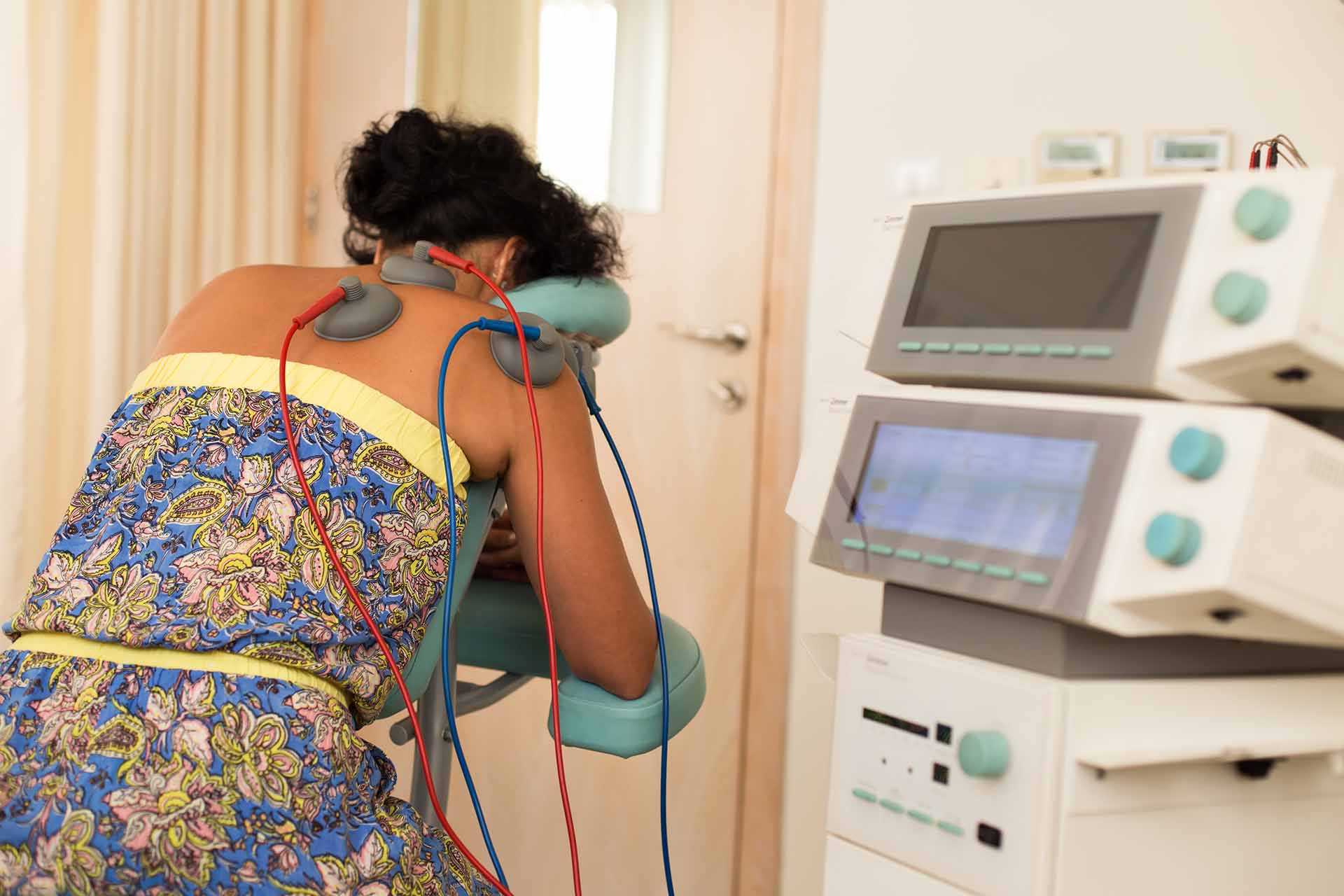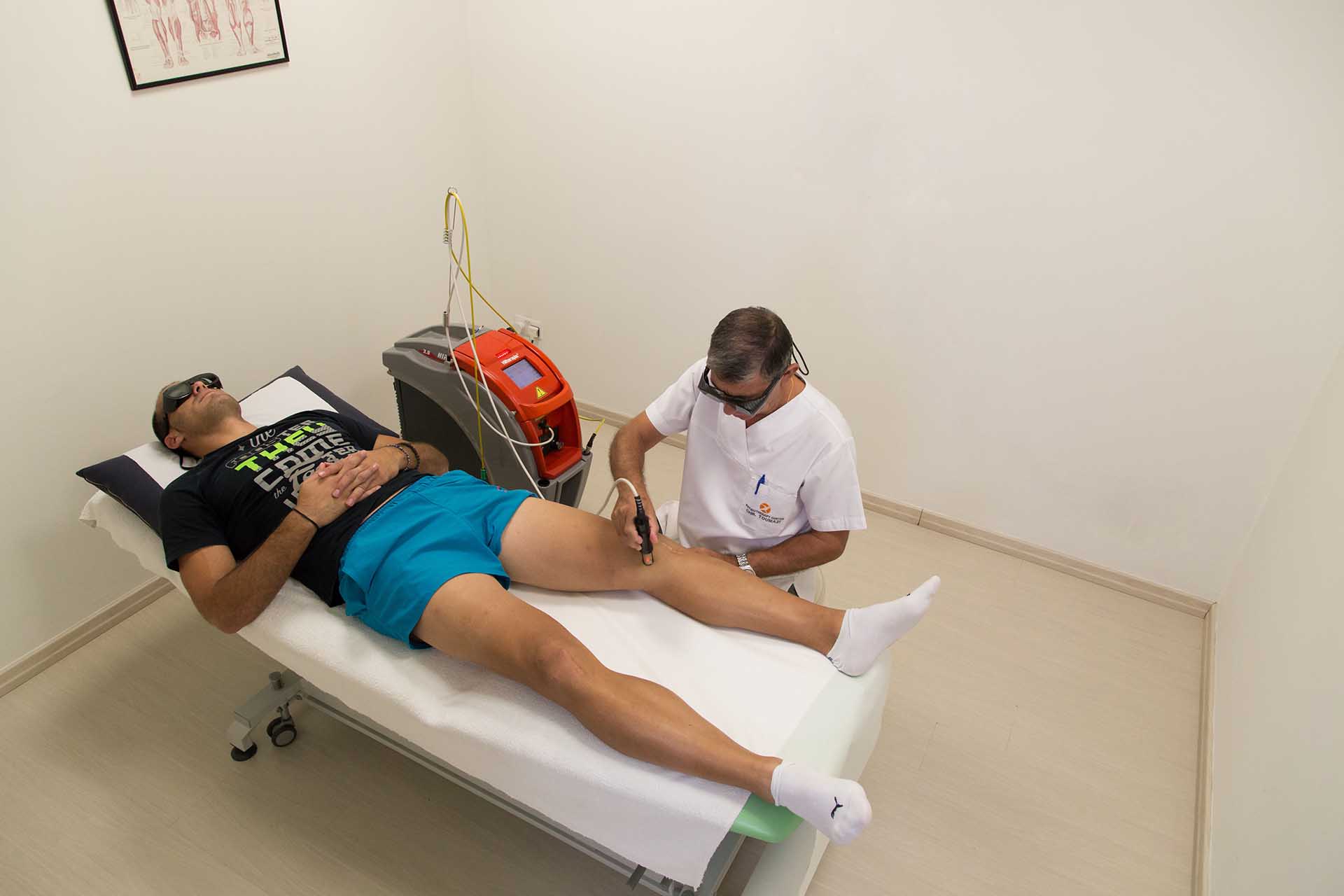- Electrotherapy
- Ultrasound Therapy
- Shockwave Therapy
- Magnetic Therapy
- Diathermy
- Hilterapia Laser Therapy
Electrotherapy is a physical therapeutic treatment where electrical stimulation is applied to nerves and muscles via electro-pads placed on the skin. Electrotherapy includes different types of methods such as electrical, ultrasound, shockwave, diathermy and magnetic.
It is used to assist pain reduction and maximize the natural healing response. Its short-term benefits can assist with the earlier introduction of other longer lasting techniques such as exercise prescription.
While many patients will feel the immediate benefits from electrotherapy and will allow them to continue moving and functioning as comfortable as possible, it is wise to think of the more long-term suggested exercise to strengthen the muscles until the problem is fixed.
Through electrotherapy the following effects are achieved:
- reducing localized inflammation
- increasing blood flow
- stimulating muscles
- triggering the release of endorphins, hormones that act as the body’s natural analgesic
Ultrasound is a passive treatment that the therapist administers and it is a supplement to the primary treatment (eg, therapeutic stretching, exercise). Ultrasound can help relax tight muscles that are sore, and warms muscles and soft tissues, which increases circulation that helps healing.
Ultrasound equipment generates high-frequency sound waves that are transferred to a specific body area via a round-headed probe. The sound waves travel deep into tissue (eg. muscles), creating gentle heat.The heat helps relieve pain and inflammation, reduce muscle spasms, and accelerate healing. Depending on the treatment area, range of motion may be increased.
The three primary benefits to ultrasound are:
- The speeding up of the healing process from the increase in blood flow in the treated area.
- The decrease in pain from the reduction of swelling and oedema.
- The gentle massage of muscles tendons and/or ligaments in the treated area because no strain is added and any scar tissue is softened.
Shockwaves are acoustic waves with an extremely high energy and differ from ultrasound by their extremely large pressure amplitude. Though ultrasound consists of a periodic oscillation, a shockwave is a single pulse.
Shockwave therapy is leading the way in pain management. In many instances, there will be an immediate reduction in pain, as well as improved mobility and functionality.
Shock waves effects:
They stimulate the epidermal fibers of the peripheral nerves that trigger the mechanisms that avoid and reduce the pain in the posterior horn of the spinal cord.
They change the local environment of the cells to attract the substances that block the pain stimulus.
They stimulate the release of endorphins, which reduce local pain sensitivity.
They activate the automatic healing mechanisms of the organism.
Shockwave therapy benefits:
- Pain relief in just a few sessions if not at once
- Fast and effective
- Drug free
- Pain free
- No side effects
Magnetic therapy is the one of the most advanced, safe and pain free therapeutic methods used through pulsating magnetic fields. It’s a very effective form of physical therapy and it is simply a physical (or biophysical) modality used for fast healing purposes.
It’s very efficient and simple to use as a therapy method. The cellular functions can be significantly improved by influencing the patient either generally or locally with a magnetic field applied in impulsed bundles.
Benefits and effects:
- Increases blood circulation
- Reduces Swelling
- Pain relief
- Has no effect on heart rate or blood pressure
- Injured tissues are regenerated faster which means a faster healing
- Increases oxygen use by all cells in the areas treated
- Improves energy condition of all cells treated
- Improves body defences against infection and inflammation
- No side effects
Diathermy treatment is a form of physical heating therapy of a person or body part to achieve a therapeutic benefit. It targets the damaged tissue, uses heat to relax the tight tissue, increases blood flow, and reduces the swelling. This form of thermal therapy is typically used to treat muscle spasms or tension, stiff joints, and muscle and joint pain.
Effects and Benefits:
- This therapeutic heat can increase circulation, accelerate healing, control pain, and It can increase soft tissue extensibility.
- It benefits patients with pain and those with restrictions in joint or soft tissue mobility.
- Diathermy is the only way to heat large deep areas.
- Therapeutic heating influences hemodynamic, metabolic and neuromuscular processes and increases the extensibility of soft tissues.
- Increases the rate of blood flow to accelerate the delivery of oxygen.
- Therapeutic heating causes vasodilatation by stimulating thermo receptors that directly cause vascular smooth muscle relaxation and indirectly activate local spinal cord reflexes.
Laser therapy is one of the most important achievements of the 20th century that has opened up new avenues in the development of the science of physical therapy. Laser therapies are medical treatments that use focused light. Unlike most light sources, laser light is tuned to very specific wavelengths. This allows it to be focused into powerful beams.
10 principal results of laser treatment:
- Rejuvenates and regenerates cells
- Fights symptoms of neck pain and back pain effectively
- Soothes the aching muscles and joints
- Helps with the hematoma absorption
- Regenerates the skin from wounds and burns
- Makes scars durable and elastic for pain relief
- Fuels the cells with more oxygen and improves collagen synthesis and protein in the skin
- Contributes in the quick recovery of fractures and sports injuries
- Increases the strength of the nerve cells
- Quickly heals injured blood vessels






